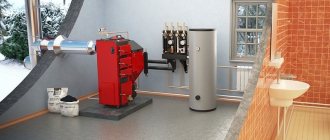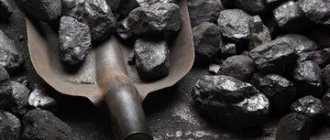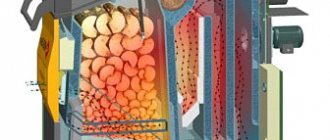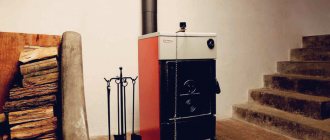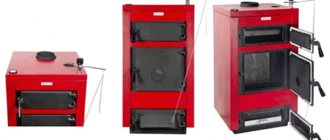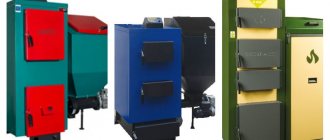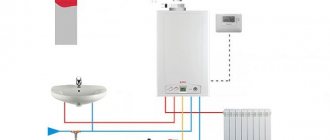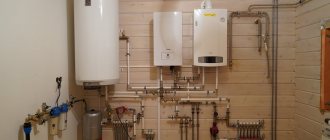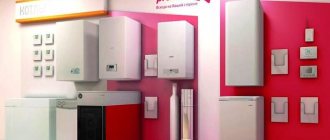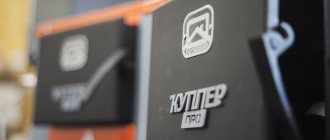Home / Solid fuel boilers
Back to
Published: 14.05.2019
Reading time: 5 min
0
1676
Boiler manufacturers offer a wide range of boilers, differing in characteristics, purpose, fuel type and quality. Industrial boilers can be gas, electric, solid fuel, gas and oil, combined, hot water and steam.
Industrial boilers for solid fuels are used by enterprises for heating and hot water supply. Such equipment is used in industrial, administrative, commercial, agricultural buildings. Since such rooms, as a rule, are large in area, powerful equipment is used there that runs on solid fuels (pellets, briquettes, coal) with a capacity of 100 kW and more.
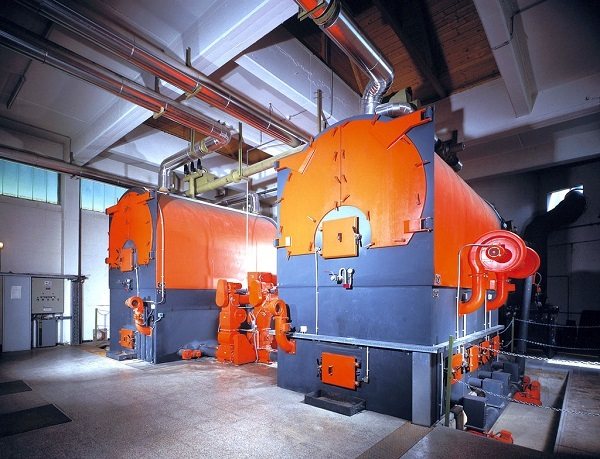
- 1 Pros and cons of industrial solid fuel boilers
- 2 Types of industrial boilers for solid fuels 2.1 Steam boilers
- 2.2 Hot water
- 4.1 Requirements for TT boiler rooms
Types of hot water boilers
Such heating equipment has been used for more than a dozen years, constantly improving with the advent of new developments and technologies. This led to the fact that solid fuel boilers for industrial use are presented in a large assortment and it is rather difficult for a consumer who does not have specific knowledge to understand it.
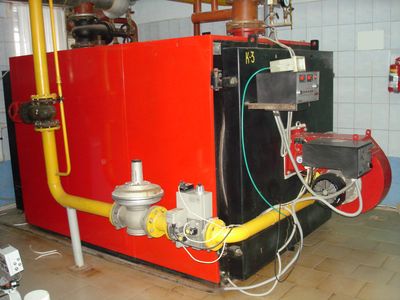

Therefore, when choosing, you need expert advice, and we will consider the main types of equipment operating on solid fuel:
- It is most advantageous for a woodworking company to install a wood waste boiler. These industrial units are unpretentious in maintenance and operate on any production waste: shavings, sawdust and even wood dust. The only caveat is the requirement that fine-grained waste be no more than 30% of the mass of one fuel tab.
- Agricultural and food industries often install solid fuel steam boilers. A large amount of steam that this equipment is capable of producing is needed for the production needs of such industries (drying or humidifying products).
- For heating large areas, industrial coal-fired boilers are used. Mechanized fuel supply and forced mixing ensure complete fuel burnout, which significantly increases the efficiency of such units. It should be noted that powerful devices from 2.5 MW differ significantly in configuration from smaller analogs. Their performance is sufficient even for the processing of wet fuel.
- Apparatuses working on briquettes are rarely used. A feature of pressed fuel (most often woodworking waste) is a large release of soot and soot, clogging chimneys.
- Large capacity wood-fired hot water boilers are used for heating large areas of industrial and residential use. In addition to firewood, the unit can operate on other solid fuels. Automatic fuel supply and movable grates make the operation of the equipment simple and convenient. Some models are equipped with pre-furnaces, where the raw material is dried before entering the combustion chamber.
Advice! Combined hot water units operating on several types of fuel are considered the most successful and popular. But their lineup is severely limited by the complexity of the production and operation of such equipment.
General information about this type of heating heating technology
In principle, a hot water boiler is no different from the operation of another heating device that heats the coolant using thermal energy. Almost any fossil or organic fuel of solid texture and various fractions goes into the furnace. Firewood, coal, fuel briquettes, everything that burns well and is available in constant volumes is fuel for this type of boiler equipment.
Usually, such units are installed in those places where there is a certain type of fuel in constant and large quantities. Wood-processing enterprises have boilers that run on firewood and wood-processing waste. In small boiler houses, coal and brown coal is used for burning devices. Less often, fuel briquettes from peat, pellets go into the furnace. The maximum possible thermal effect is achieved when using anthracite or beneficiated ore, coke. For such heating equipment, which are hot water boilers, a high heat transfer effect is characteristic. Due to the large screen surface of the heat exchanger, it is possible to bring large volumes of water to the required temperature.
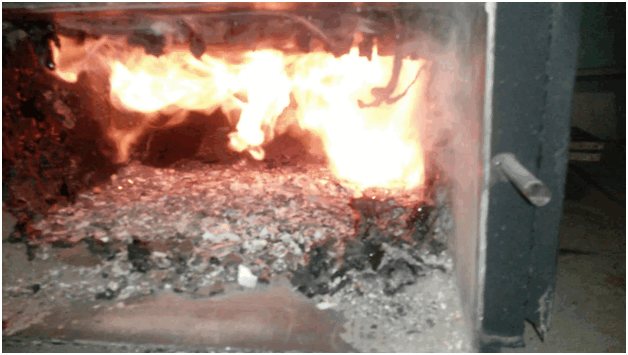

For instance: During combustion, 1 kg of anthracite coal releases up to 7.16 kW of thermal energy during combustion in the furnace of a heating boiler. Dry hardwood firewood emit only 2.78 kW.
Despite the fact that hot water boilers for solid fuels in comparison with gas boilers have low efficiency (only 78% for coal and 70% for wood), the economic costs spent on heating a large amount of water in this way are quite justified.
Other types of solid fuel units have a limited load. On the contrary, water heating devices have a large power reserve, they are capable of operating under a constant heavy load. The greatest thermal effect is achieved due to the use of a large number of heat exchange elements in the design, through which boiler water is heated for heating and hot water supply. The principle of operation of this type of heating equipment differs from the operation of other solid fuel heating devices.
Benefits of solid fuel equipment
Solid fuel equipment is an economically viable substitute for gas counterparts. The availability of cheap fuel in some cases makes the installation of such boilers the only cost-effective alternative. In addition, gas equipment requires special permits and approvals from the service personnel.
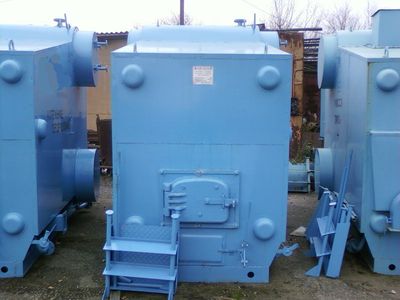

Other advantages that industrial solid fuel boilers have are:
- Ease of operation and unpretentious maintenance.
- Possibility to create complexes of increased power - up to 40 MW.
- A wide range of solid fuel options, you can choose the most affordable and profitable in a particular case.
- Having such a device in production, you can significantly save twice: on fuel, burning solid waste, and on disposal - they will no longer need to be taken out.
The presence of mechanized fuel supply and automatic control over the equipment allow to reduce the staff of the service personnel as much as possible.
The only drawback of heating systems in which industrial hot water boilers operating on solid fuels are used is the following factor. Due to the release of a large amount of soot and soot, periodic maintenance and cleaning of chimneys is necessary.
Advice! Such cleaning can be carried out with special mechanisms at the end of the heating season.
The main advantages of industrial-type solid fuel boilers
The main advantage of industrial solid fuel units is the maximum possible gas savings. Using gas for heating industrial facilities is an unaffordable luxury in our time.The use of a solid fuel heating system in production gives real savings by 2-3 times.
Other advantages of such equipment include the following aspects:
- wear resistance of equipment;
- versatility;
- high profitability and quick payback;
- wide range of applications and ease of maintenance.
In terms of durability, industrial boiler models have high performance. The use of the highest quality materials for the manufacture allows achieving long service life.
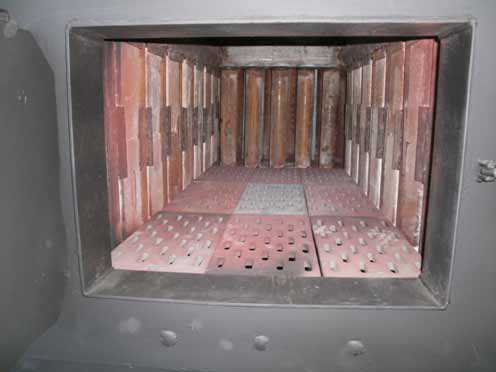

For reference: some models have a guaranteed service life of 10-15 years.
The versatility of solid fuel boilers is omnivorous in terms of fuel. Any fossil fuel available at the moment can be used as the main one. If we talk about profitability and payback, industrial solid fuel units are highly efficient economically. The ratio works here: cheap fuel in constant volumes - high heat transfer, a lot of heat and long-term operation.
The funds invested in the equipment pay off in 2-3 heating seasons.
Most of the models that are produced today are equipped with special devices that ensure minimal dependence on the electrical supply. Connection to autonomous electric generators guarantees the operation of the exhaust ventilation in a standby mode, which allows industrial boilers to be constantly in working order.
The device and principle of operation of hot water boilers
Solid fuel hot water boiler is a modular design, made in a single body, and has the following main units and mechanisms:
- heat exchanger;
- heat exchanger hatch for cleaning and maintenance;
- combustion chamber door;
- combustion chamber with grate system;
- grate cleaning mechanism;
- fuel supply mechanism.
In addition, a solid fuel boiler is equipped with an air pump that maintains the required combustion level.
Principle of operation
The principle of operation of industrial boilers is the same as that of smaller counterparts:
- The fuel, burning in the combustion chamber, heats the water circulating in the heat exchanger, which is connected to the heating system.
- The intensity of combustion and the speed of movement of gases in the combustion chamber is regulated by the injection and flue gas pump.
- The movement of the coolant in the system is provided by efficient circulation pumps.
- The safety group and safety valves in the flue ducts provide protection against overheating and explosion of combustible gases.
- After complete combustion of the fuel, the ash enters the ash pan, from where it is removed mechanically through a special hatch.
Advice! On sale there are both domestic and foreign industrial boilers operating on solid fuels. It is worth choosing domestic developments, since they are more adapted to difficult working conditions.
Solid fuel hot water boilers are quite common in all regions. It is beneficial to use them in industries and other places where there is access to a cheap type of solid fuel. Also, such equipment is used for heating residential areas where it is not possible to conduct a gas main.
What is the secret of the popularity of solid fuel industrial boilers
Solid fuel boilers for industrial use occupy a special place in the model range of high-power heating units. Interest in this kind of technique has increased significantly recently. The reason for the popularity of solid fuel boilers is their high efficiency. The rise in natural gas prices is forcing owners of enterprises, firms and companies to use other types of fuel, trying to reduce heating costs in the cold season.
Modern models that are produced by domestic and foreign manufacturers have not only enormous power, but also represent high-tech equipment. Now, when evaluating the parameters of an industrial heating device, it is not so much its power that is assessed, but rather the economy, efficiency and safety of operation.
Almost any autonomous heating system equipped at an enterprise is a complex complex that combines various devices, devices and mechanisms. An industrial solid fuel boiler is by far the best engineering solution, especially if it is possible to get constant access to a solid fuel source. Coal, firewood, pellets or peat briquettes, any of the listed types of fossil fuels are cheaper than natural gas. In any region of our country there is always an opportunity to choose which type of fuel to give preference to.
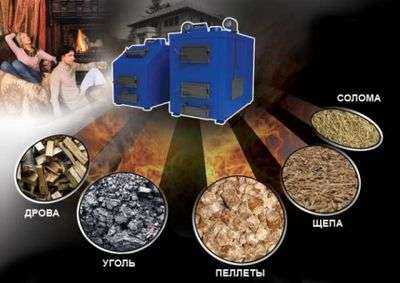

For reference: 100% of the pulp and paper and woodworking enterprises in the country use their own production waste for the heating system. The installation of one or more industrial boilers at the enterprise, operating on pellets or secondary raw materials, is able to completely solve the issue of heating industrial premises and hot water supply.
For enterprises of the woodworking industry, the problem of organizing heating is generally solved automatically. Pyrolysis boilers operating on wood and pellets successfully cope with the tasks assigned to them. Fuel in this situation has an inexhaustible resource. The supply of fuel for enterprises and companies of various profiles, which are located in industrial zones, is organized in a similar way. The proximity of railways facilitates the supply of coal or coke, which are used as fuel for solid fuel boilers.
Appointment
Solid fuel hot water boilers allow you to get heating and hot water in places where there is no gas pipeline and the use of gas-oil boilers is not profitable, while receiving rather inexpensive heat, long operation and safety. At present, long-term vapor-lysis units are mainly used. Unlike classical systems, steam-lysis boilers require less fuel loading, and their efficiency is higher due to the afterburning of carbon dioxide released during fuel combustion.
Solid fuel industrial boilers are single-circuit and double-circuit. Usually, for industrial purposes, double-circuit hot water boilers are used, which provide not only heat in the manned room, but also hot water. A solid fuel industrial boiler does not need to be connected to the mains, which creates additional savings.
features
The most important factor in choosing a new unit is fuel, since it is fuel that constitutes the main item of consumption after purchasing equipment. Fuel is determined based on the tasks and capabilities of the region. For example, in places rich in wood, a unit operating on a DVO will work more economically than on coal. But for heating a small car workshop, for example, a waste oil boiler is better suited than even equipment using the cheapest fuel - gas. It is easier to get fuel for a coal-fired hot water boiler, and the price of the unit itself is lower than that of its competitors. But there are also such units that can operate on various solid fuels, without requiring changes in the design when changing.
The next factor is the boiler output. To correctly calculate the power, it is necessary to take into account the area of the heated room and all possible heat losses. A universal formula for boilers of low power is 1 kW per 10 m². To calculate all heat loss in industrial premises, there are special calculators with more complex formulas and taking into account all the nuances. And a specialist will be able to calculate the boiler power as accurately as possible.
Another feature of solid fuel industrial boilers is fuel supply and ash disposal. It is necessary to load fuel into these boilers at regular intervals so that the operation of the equipment does not stop. And as a result of burning solid fuels, waste is formed. These two factors force a person to constantly regulate the process and be in the boiler room. But if this option is unacceptable, then all boilers can be equipped with automatic fuel supply or cleaning systems from slag and ash. And you can do both. Accordingly, the price of such equipment will increase. Therefore, it is also necessary to take into account the degree of automation when choosing boiler equipment.
And the most important factor when choosing a boiler is the manufacturer. A solid fuel hot water boiler is a device that operates at high temperatures and pressures, so it is important to choose a safe and proven product. Experts recommend taking boilers from Russian manufacturers, because they are designed for the difficult climatic conditions of individual regions and are much cheaper than foreign counterparts, since their production is usually local. It is also recommended to use control and automation systems for industrial units, which increase the safety of the boiler room.
Thus, we can conclude that when choosing a boiler, it is important to take into account the availability of any fuel in the region, the area and degree of heating of the room, the need for automation and a trusted manufacturer.
manufactures modern industrial hot water boilers for solid fuels that meet all the necessary quality and safety standards. We give a guarantee for our boilers up to two years, and our own production base allows us to keep prices low. You can buy a solid fuel hot water boiler on our website or order a call through the feedback form, and our manager will contact you where he will provide professional assistance in choosing a boiler.
Features of industrial boilers for solid fuels
Heating devices used for industrial purposes have not only high power, but also, accordingly, large dimensions. The installation of an industrial solid fuel boiler requires a prepared room that must meet all necessary safety norms and standards.
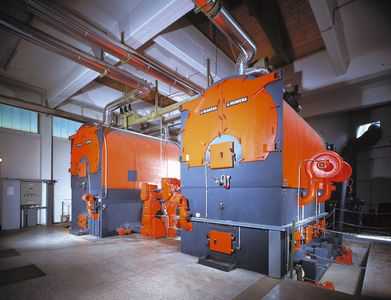

As a rule, the installation, connection and maintenance of industrial solid fuel boilers are carried out by specialized enterprises with the appropriate technical base and qualified personnel.
Solid fuel boilers are classified as industrial equipment if their capacity is 100 kW or more. On average, it is considered:
- a boiler with a capacity of 100 kW is capable of heating a room with an area of 1000 m 2;
- a 300 kW boiler is designed to heat industrial premises, the area of which reaches 3000 sq. m;
- some models of industrial boilers develop a capacity of 1 MW or more.
Warehouses, factory halls are heated by the operation of several heating boilers, which are connected to a single heating system. The total power in some cases can be up to 10 MW. Such heating systems are used mainly in metallurgical and mining and processing enterprises, where there is a large amount of natural fuel and a huge production area needs to be heated.
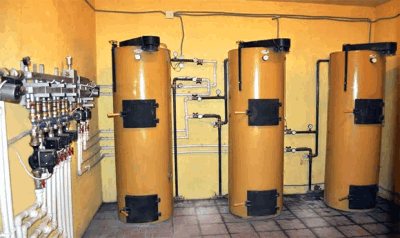

For reference: a boiler with a capacity of 1.5 MW is able to organize efficient heating of an industrial enterprise of a medium level, including the organization of a hot water supply system.
In some cases, the automation of the cleaning and soot removal process is provided, which greatly simplifies and facilitates the work of the stoker. Fuel supply systems can be either manual, semi-automatic or fully automated.
The main design feature of industrial boilers is the presence of a steel heat exchanger welded from high-strength steel, the thickness of which reaches 10 mm. Such a heat exchanger is able to withstand high temperatures, is very convenient and practical in terms of operation.
Types of hot water TT boilers
A solid fuel boiler is a heating device that uses the energy of burning solid fuel. Most often it is firewood or coal. However, some manufacturers produce models that work on pellets and fuel briquettes.
By the type of solid fuel used, boilers are divided into:
wood burning
This category includes conventional wood-fired boilers. Their downside is that wood has low heat transfer and burns out quickly. Therefore, it is necessary to add firewood to the firebox every 2-4 hours.
coal
Coal boilers operate on brown or black coal, anthracite, coke. The heat transfer of coal is 2 times higher than that of wood, besides, coal is more compact. One bookmark will last for 8-10 hours.
pellet
Pellet hot water heating boilers operate on special granules - pellets. They have a high efficiency of 85-95%. Their significant disadvantage is the high cost of the devices themselves and the fuel for them.
universal
They can work on wood, coal or pellets to choose from. The efficiency of universal boilers is lower than that of those using one type of fuel. Manufacturers also produce two-fired models. Each type of fuel has its own combustion chamber and its own heat exchanger.
Photo 1: Fuel pellets for solid fuel boiler
According to the material of the heat exchanger, they are divided into:
cast iron
The advantage of the cast iron heat exchanger is its high heat capacity and resistance to corrosion. Such products will last 30% longer than steel counterparts. The disadvantage of cast iron heat exchangers is fragility and sensitivity to temperature extremes. We also note that cast iron is 2-3 times heavier than steel, as a result of which even low-power models have to be installed on a concrete foundation.
steel
Boilers with a steel heat exchanger are 30-60% cheaper than their cast iron counterparts. The disadvantage of a steel heat exchanger is the formation of corrosion due to condensation water.
There are two ways to burn solid fuels: classic and pyrolysis. Depending on which method is used, all models are divided into two types:
classic
In classic boilers, the combustion process takes place naturally. They are characterized by simplicity of design, and as a result, a low price. Their disadvantage is their low efficiency (75-85 percent) due to incomplete fuel combustion.
pyrolysis (or gas generating)
A feature of these devices is that solid fuel and the gas emitted by it burn separately. This achieves a higher efficiency compared to classical ones (about 85-92%). Such devices are much more economical and environmentally friendly than classical ones. Modern heating boilers for pyrolysis combustion are about 1.5 times more expensive than traditional ones.
According to the loading method, solid fuel boilers are distinguished:
with manual loading
To maintain a constant heating temperature, it is necessary to manually add a new portion of solid fuel every 2-4 hours.
with automatic loading
The design of the heating system is complemented by bunkers for automatic fuel supply. Depending on the volume of the bunker and the amount of solid fuel in it, the battery life reaches from several tens of hours to one month.
Photo 2: Boiler with automatic fuel supply
According to the degree of dependence on electricity, they are divided into:
non-volatile
In volatile boilers, the air will be forced into the combustion chamber by a mechanical thermosyphon.
volatile
Volatile boilers use an electric fan to force air into the combustion chamber. This process is controlled by an electronic unit that requires an electrical connection.
We figured out the classification, now let's look at the device and principle of operation of the TT of the heating boiler. It consists of the following components and assemblies:
Combustion chamber
The fuel combustion process takes place in this section of the boiler;
Heat exchanger
This device is made of cast iron or steel. It transfers the energy of the burning fuel to the coolant;
Cleaning hatch
Especially the hole in the ash pan. Ash and combustion waste are extracted through it;
Grate
A metal grate between the combustion chamber and the ash pan on which the combustion process takes place. Ash falls through holes in the grate into the ash pan, from where it is then manually removed;
Thermostat
A mechanical or automatic device that regulates the intensity of combustion, and therefore the temperature of the coolant;
Photo 3: Arrangement of a wood-fired hot water boiler
The operation of a boiler with a water heating circuit is very simple. Solid fuel is placed through the loading door into the combustion chamber. During combustion, the heat exchanger heats up and transfers energy to the heat carrier, for example water. The coolant circulates through the heating system, heating the room. Ash and other wastes from combustion accumulate in the ash pan.
Construction of hot water solid fuel boilers
To imagine exactly how this equipment works, consider the device of a solid fuel hot water boiler. Traditionally, this is a welded metal structure in which a support frame is provided, that is, a frame sheathed with protective heat-insulating materials. The unit is based on a complex system of water pipelines, that is, a heat exchanger through which water heated in the boiler circulates. Outside, the entire structure is closed with sheet metal.
The structure of a hot water boiler itself, as well as the principles of its functioning, testify to the large dimensions of such equipment. In addition, depending on the models, the fuel chambers can be equipped with different solid fuel delivery systems.
If we consider a solid fuel boiler of industrial production, then it is a single unit, all elements of which can be conditionally divided into two groups - with a screen surface and with a convective surface (read: "What are industrial hot water boilers - types, advantages and disadvantages").
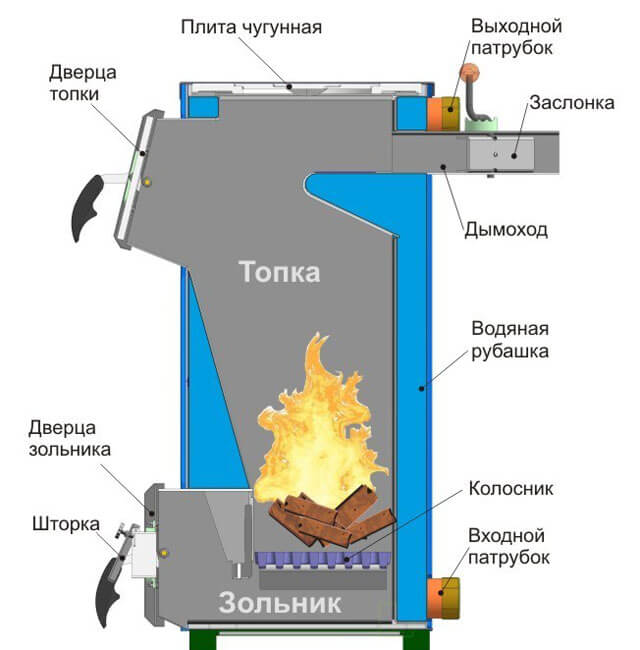

Structural elements are made from solid-rolled steel pipes with a cross section of 76 mm. Fins must be installed between them. This design of the heat exchanger minimizes heat loss and prevents the leakage of combustion products through the boiler drum. The connection of pipe sections to each other is carried out using welded seams designed for pressures up to 10 atmospheres.
Please note that the water heating circuit must only be welded. Moreover, all work must be performed very carefully, since the equipment is operated under high temperature and pressure conditions.
Firewood or coal is fed into a fuel chamber equipped with standard or rotary grates (they are used in manual boilers). During the installation of a hot water boiler, an air duct is installed in the frame under the firebox, through which air will be supplied for fuel combustion.
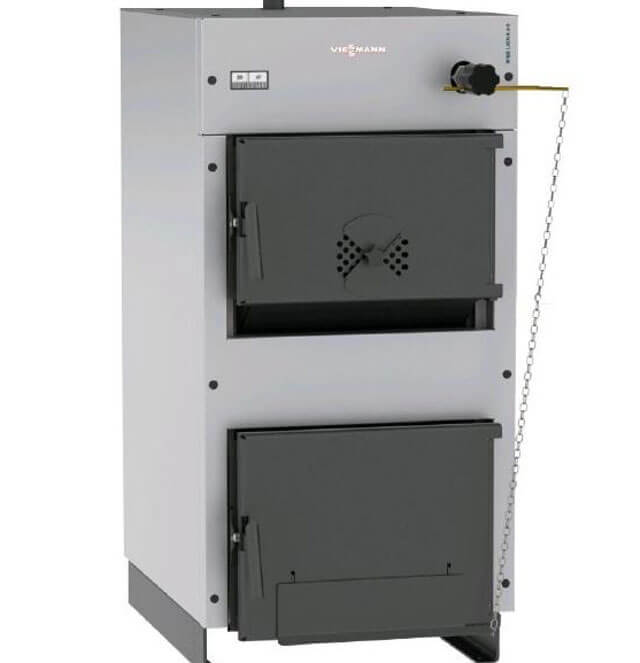

Any equipment needs periodic cleaning. If the boiler is provided with manual fuel supply, then soot and ash will have to be removed through a special hatch. But in those hot water boilers that are equipped with a mechanical feed system, all work is done using special devices - mechanical conveyors.
Distinctive features
The long-burning double-circuit solid fuel boiler is a modernized version of the classic heating equipment.
In it, among other things, there is also a built-in heat exchanger, which provides the dwelling with a full-fledged hot water supply.
The design of the two-contour model includes the following elements:
- Housing - can be produced from sheet steel or cast iron. The thickness of the metal is 4 to 6 mm.
- Furnace chamber... Usually made from the same material as the body of the instrument.
- Grate type... It is located inside the combustion chamber, the material is cast iron. Enriches the fuel with the oxygen necessary to maintain combustion.
- Ash pan... Accumulates solid waste generated during combustion.
- Chimney - removes combustion products outside the room.
- "Water jacket"... Most often, it is built into the boiler body and filled with water, which receives heat from the walls, after which it enters the heating system.
- Additional heat exchanger coil - distinguishes double-circuit models from single-circuit ones. It is built into the water jacket of heating equipment to provide hot water supply to the house.
The main disadvantage of this design is the low degree of performance.... Therefore, models made of cast iron are more popular, since they cool down longer.
Investment projects in the field of production of boiler equipment
According to the portal "Investment Projects of Russia" https://investprojects.info/ as of September 2020, there are 2 investment projects in the boiler equipment manufacturing industry at the stage of pre-design development and implementation: expansion of the plant for the production of heating equipment and automation (CJSC Omzit ", investment volume 800 million rubles) in Omsk, reconstruction of a plant for the production of boiler equipment in the Leningrad region (LLC" Signal ", investment volume of about 300 million rubles).
Types of devices
According to the method of fuel combustion, long-burning double-circuit boilers can be subdivided into:
- Pyrolysis... Equipped with two combustion chambers. In one of them, the process of smoldering and gas evolution for pyrolysis occurs, in the other, the resulting gas is mixed with oxygen and burned. Equipment of this type is characterized by high environmental friendliness - a minimum amount of harmful substances is released into the atmosphere. The combustion process produces little soot. If the boiler is equipped with automation, it will also be possible to adjust the power.
- With an upper combustion chamber... These boilers are very easy to maintain. The number of automatics for their stable operation needs a minimum, it is possible to operate in an autonomous mode of operation without electricity. There are also disadvantages - a lot of ash is formed during operation, there is a list of requirements for the types of fuel. For example, small wood chips or sawdust are not suitable for kindling.
- Pellet... For kindling such equipment, special pellets or compressed fuel briquettes are used. Such boilers are environmentally friendly, economical and efficient, and have a long service life. One of the main disadvantages is the high price of the boiler and the special conditions that will have to be maintained for storing fuel. The room must be dry, high air humidity will deteriorate the pellets.
The device and principle of operation of industrial gas boilers
The principle of operation of the heating device is based on the combustion of gas in the furnace with concomitant heating of the coolant. On this basis, boilers are divided into two groups:
- with hot air circulation (fire-tube);
- with the heating of the liquid almost to the boiling point (water tube).
Steam boilers are installed in enterprises that use steam in industrial production.
Reference. The cost of natural gas and its calorific value are unrivaled by other natural combustible materials. Therefore, the use of natural gas provides significant economic benefits.
Gas-burner
The main part of any boiler is the burner. They are divided by the type of gas supply:
- for injectionsucking in gas together with an air stream;
- on superchargedusing forced air injection by a powerful fan;
- to diffusesupplying gas to the place of combustion through special diffusion channels.
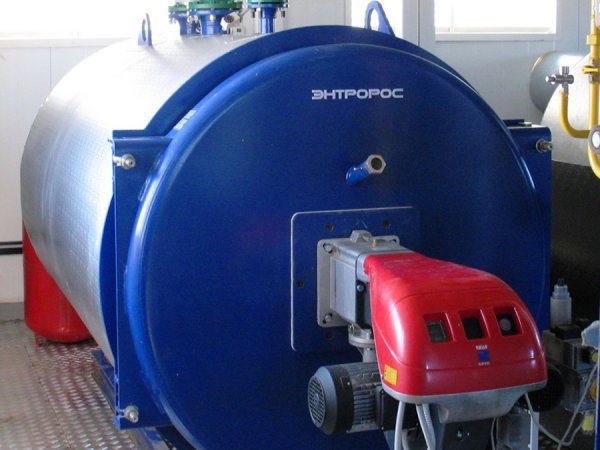

Photo 1. Entroros industrial gas boiler. A pressurized gas burner is installed in the device.
A common burner design is a set of several parallel rod devices that are evenly spaced throughout the entire volume of the furnace. They are equipped with holes for the gas / air mixture to escape and provide uniform heating. To increase efficiency, a pipeline with a coolant is placed between the rods. Such installations are able to achieve The efficiency is 98-99%.
Another popular burner option for an industrial boiler with a capacity from 100 kW and more has a torch device. On one of the walls of the unit, a special nozzle is arranged, into which a gas-air mixture is injected. Flare combustion has shown itself well in two and three-pass boilers, it is used to obtain a coolant with a temperature 115-120 degrees or a couple.
Combustion chamber
For heating a powerful boiler it is important to withstand high temperatures for a long time. Heat resistance is ensured by the use of special steels with the addition of manganese, chromium and other alloying components. The walls are reinforced with corrugation and surrounded by a heat-insulating sheath.
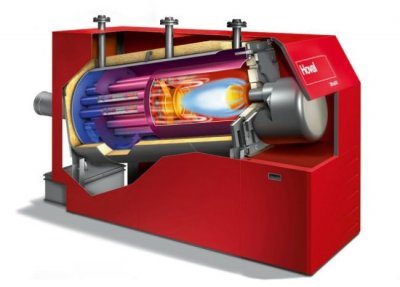

In hot water boilers in the firebox they place one or two heat exchange circuitsthrough which the coolant circulates.
In steam or high-pressure boilers, firewalls and a heat exchanger are used to generate heat, and steam is generated in the chimney, where the temperature of the flue gases decreases up to 600-800 ° C.
A separator and a superheater are placed in the combustion chamber of a steam boiler.
Explosion valve ensures operational safety, which must be installed on one (more often the back) wall of the boiler. The mechanism is triggered if the pressure in the furnace is exceeded.
Automation and control system
The complexity of controlling an industrial boiler is associated with constantly changing water temperature and pressure, instantaneous gas flow rate, air intake for the burner and other factors.
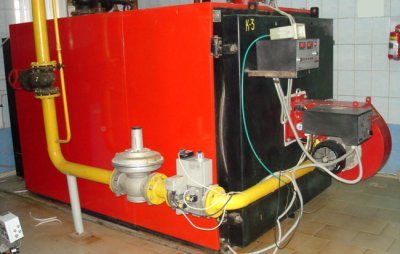

To eliminate the human factor, all management is carried out using special controllers.
Data for their operation comes from temperature, pressure, air and gas flow sensors. For greater reliability in modern boilers, automation divided into two parts:
- Fuel supply automation, which is responsible for the operation of the modulating burner and maintaining the stable operation of the entire system.
- Safety automation takes into account the critical operating conditions of the boiler, the presence of a flame in the furnace, gas supply, heating of the coolant. In the event of a malfunction, the boiler shuts down and the fuel supply is cut off. Some boiler models are equipped with self-diagnosis systems.
Attention! Natural gas is commonly used: methane... It is lighter than air and is an optimal fuel. In some cases, it is allowed combustion of propane-butane mixture... This gas is heavier than air and requires proper adjustment of the equipment.
How to choose and what to look for?
The most important indicators when choosing solid fuel boilers for long burning with a built-in water circuit are:
- Availability of the required fuel.
- The power level of the device - depends on the area of the heated rooms and the required temperature regime of the coolant.
- The type of draft generated inside the combustion chamber. It can be forced or natural. This parameter affects the possibility of placement in a particular room and the level of boiler performance.
- Efficiency. It will depend on the type of fuel used, design features and additional equipment used (presence or absence of an exhaust hood, automation of fuel supply, etc.).
- The heat exchanger material - usually cast iron or steel - affects the reliability of the device and the characteristics of the heating technology.
- The type of location of the water jacket is important in order to correctly determine the installation location of the boiler in terms of fire safety rules.
- The weight of the unit is an important factor in determining the base where the boiler will be located. It must be strong enough and not subject to deformation.
- The method of fuel loading and the dimensions of the combustion chamber are important for determining the cycle of use of the unit and the possibility of setting up its automated maintenance.
- The design features of the ash pan and its accessibility will affect the convenience of performing maintenance and preventive maintenance work on the boiler.
- Cost Level - Depends on a combination of the factors listed above and the OEM's brand reputation.
Block-modular solid fuel boilers
For the convenience of consumers and simplification of installation, fully equipped and ready-to-use boiler houses are assembled at the factory.
There are two types of modules:
- Container block-modular solid fuel boiler house. It is assembled in insulated metal containers installed using loading equipment. The advantage of the design is the possibility of freely completing and increasing the productivity of the station at the request of the customer. The disadvantage is the high requirements for installation and the large time required for installation.
- Mobile block-modular boiler houses based on solid fuel boilers. The stations are installed on a vehicle frame with wheels. By their design, they resemble a car trailer. The station is easy to install and connect, but it has limitations in terms of performance and equipment.
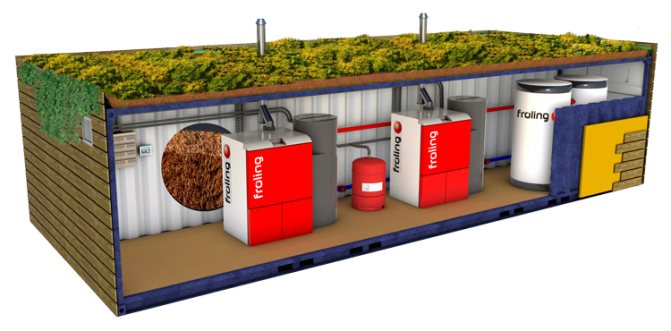

Regardless of the type chosen, BMK are equipped with the following:
- Heating equipment - BMK are equipped with models of world boiler manufacturers. Optionally, you can choose the German Buderus or the domestic ZOTA, etc.
- Automation - a control panel is installed in the boiler room. The operation of the boiler is monitored by one operator, who controls the heating of the coolant. Automation fully regulates the workflow: fuel and air supply.
- Water treatment and safety system.
Fuel consumption in BMK is 20-30% less than in industrial boilers purchased separately. Thanks to the factory settings and equipment, it is possible to achieve maximum efficiency and economy.
Requirements for BMK solid fuel
During the assembly of the module, all installed equipment is registered with the state supervisory authorities, in particular Rostekhnadzor. After layout, the manufacturer invites a representative of the supervisory authorities and carries out the launch and commissioning of the station.
The consumer receives a completely finished boiler room. All devices and equipment are configured and ready for use. To get started, you will need to connect the power supply and heating system to specially designed outlets for this. After that, you can start the BMK.
The technical characteristics of the BMK on solid fuel are fully consistent with those declared by the manufacturer and do not change during operation. Installation and connection of the boiler room is carried out by a representative of the manufacturer. If necessary, independent connection is allowed.
Popular manufacturing companies
Heating equipment is always in high demand, which is why most of the technically developed world countries are engaged in the production of such units.
The following brands are best known from foreign manufacturers:
- Stropuva - manufactures long-burning boilers operating on solid fuels, chimneys and water heating systems, as well as shut-off and control valves (Lithuania).
- Buderus - German specialist in heating technology.
- WATTEK Is a Czech company dealing with a wide range of issues - design, production, installation and maintenance of heating equipment.
- ACV Is a Belgian manufacturer of equipment for heating and hot water supply for domestic and industrial use.
- Wirbel Is a company from Austria that manufactures various types of heating boilers, both solid fuel and electric.
Manufacturers
The segment is wide enough and you can find a suitable option for almost any task. For example, reliable and durable hot water boilers with a capacity of 1000-5000 kW are produced under the Byworth brand. The line includes models for solid fuel and diesel. If high industrial safety of boilers is required, then it makes sense to turn to De Dietrich Thermique products. The company manufactures a family of reliable combined units with cast iron bodies, which can be used in the service of utilities and industrial enterprises. For smaller tasks, it is worth considering the Turkish models of Erensan hot water boilers. The units are suitable for both gas fuel and liquid supply.
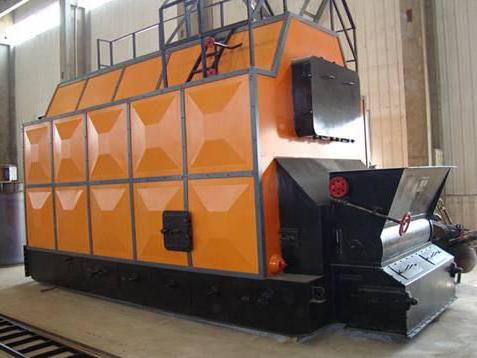

Rating of TOP-9 best models
| A place | Name | Price |
| TOP-9 of the best long-burning solid fuel boilers with a water circuit | ||
| 1 | Stropuva Mini S8 8 kW | Find out the price |
| 2 | ZOTA Topol-22VK 22 kW | Find out the price |
| 3 | ZOTA Topol-16VK 16 kW | Find out the price |
| 4 | ZOTA Topol-32VK 32 kW | Find out the price |
| 5 | Stropuva S30 30 kW | Find out the price |
| 6 | Stropuva S40 40 kW | Find out the price |
| 7 | TEPLOV Universal TA-40 40 kW | Find out the price |
| 8 | SAS UWT 14 14 kW | Find out the price |
| 9 | TRAYAN TPG-15 15 kW | Find out the price |
The best solid fuel boilers for long burning with a water circuit
Stropuva Mini S8 8 kW
Solid fuel heating boiler. able to heat a residential or industrial premises with an area of up to 80 m2.
It is efficient and fully prepared for intensive operating conditions, including year-round use. A separate advantage is independence from electricity. The boiler can work with different types of solid fuels - coal, wood, pellets.
Differs in compact size... Fuel loading is simplified by the vertical arrangement of the firebox door. The ash pan is designed so that cleaning can be done only a couple of times a month.
The special combustion technology used in this model allows for long-term fuel combustion with high efficiency..
One tab of raw materials will provide you with warmth for at least a day. Duration of pellet burning is up to 48 hours, depending on external conditions and fuel quality.
Characteristics:
- power - 8 kW;
- heated area - up to 80m2;
- purpose - heating;
- boiler volume - 40l;
- combustion chamber type - open;
- weight - 145kg;
- dimensions - 55.5 * 136.5 × 55.5 cm.
ZOTA Topol-22VK 22 kW
In this model, the configuration of the heat exchanger was successfully changed and water-filled grates were used.... The device body is reliably insulated.
It has 2 combustion chambers, due to which both horizontal and vertical fuel loading is possible. The chamber doors are securely locked.
The boiler combines a relatively low cost with a high efficiency of the device..
There is a separate door that allows ash removal even while the appliance is in operation. One load of fuel will provide you with heat for 10-12 hours.
Additionally, you can install an external control panel to block the heating element, automate the combustion process.
Characteristics:
- power - 22 kW;
- Efficiency - 70%;
- non-volatile;
- heated area - up to 200m2;
- purpose - heating;
- weight - 128kg;
- dimensions - 90.5 * 47 * 87 cm.
ZOTA Topol-16VK 16 kW
Another representative of the line of boilers with a water-filled grate, which guarantees an increase in the heat transfer of the device..
Its tube is triangular in shape, which eliminates blockages and increases service life. The boiler can consume pellets, wood or coal as fuel.
The boiler is convenient to operate, thanks to the significant dimensions of the furnace and two ways of filling fuel - it is convenient to load coal from above, and firewood - into the skewer door.
The low cost is favorably combined with the efficiency of space heating.
Characteristics:
- power - 16 kW;
- Efficiency - 70%;
- heated area - up to 160m2;
- purpose - heating;
- weight - 108kg;
- dimensions - 80.5 * 44 * 87 cm.
ZOTA Topol-32VK 32 kW
The boiler, operating on various types of solid fuels, has a high level of performance, which makes it possible to make the heating system of the house of high quality and stable.
The equipment is considered to be very practical, since it can be converted to natural gas consumption.
The equipment body has good thermal insulation, which allows it to be installed in any convenient place.
The efficiency of the device is quite high, given the low price among analogs... Single loading of fuel allows you to maintain heat in the heating system for up to 12 hours.
Characteristics:
- power - 32 kW;
- Efficiency - 70%;
- non-volatile;
- heated area - up to 320m2;
- purpose - heating;
- weight - 143kg;
- dimensions - 87 * 44 * 100.5 cm.
Stropuva S30 30 kW
Solid fuel heating boiler for residential and commercial installations... Cost effective, ready for seasonal or year round use.
Does not depend on electricity, can operate on different types of solid fuels, has a high efficiency.
Compact and does not require a separate room for installation, has a certificate of environmental safety... Duration of burning firewood - up to 30 hours, pellets - up to 2 days. No power supply required.
Characteristics:
- power - 30 kW;
- Efficiency - 85%;
- heated area - up to 300m2;
- purpose - heating;
- weight - 143kg;
- dimensions - 87 * 44 * 100.5 cm.
Stropuva S40 40 kW
Solid fuel boiler for long burning with one circuit to provide heating of premises up to 400 m2. fuel can be firewood or wood briquettes.
Has an open combustion chamber, is installed floor.
Characteristics:
- power - 40 kW;
- Efficiency - 85%;
- heated area - up to 400m2;
- purpose - heating;
- weight - 143kg;
- dimensions - 87 * 44 * 100.5 cm.
TEPLOV Universal TA-40 40 kW
Long burning water heating and heating boiler, can heat residential and industrial premises and provide them with hot water.
Suitable fuels are briquettes, wood and coal.
You can choose an automated or non-volatile device option.
In the first case, you will receive reliable protection against overheating, freezing of the liquid in the system, the ability to adjust the temperature level for day and night mode.
Characteristics:
- power - 40 kW;
- Efficiency - 82%;
- heated area - up to 400m2;
- purpose - heating and hot water supply;
- weight - 390kg;
- dimensions - 147 * 48 * 77 cm.
SAS UWT 14 14 kW
Solid fuel boiler made of steel and insulated with mineral wool to reduce heat loss... It can be installed as part of closed or open systems.
Equipped with an automatic control system.
It is possible to connect a hot water boiler.
The preferred fuel is coal, but wood-burning is also possible.
Characteristics:
- power - 14 kW;
- Efficiency - 83.5%;
- heated area - up to 120m2;
- purpose - heating;
- weight - 310kg;
- dimensions - 54 * 141 * 101 cm.

